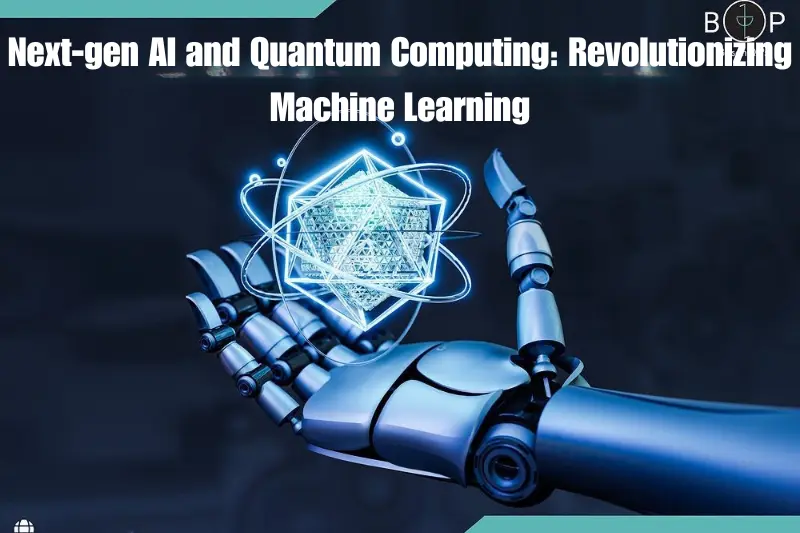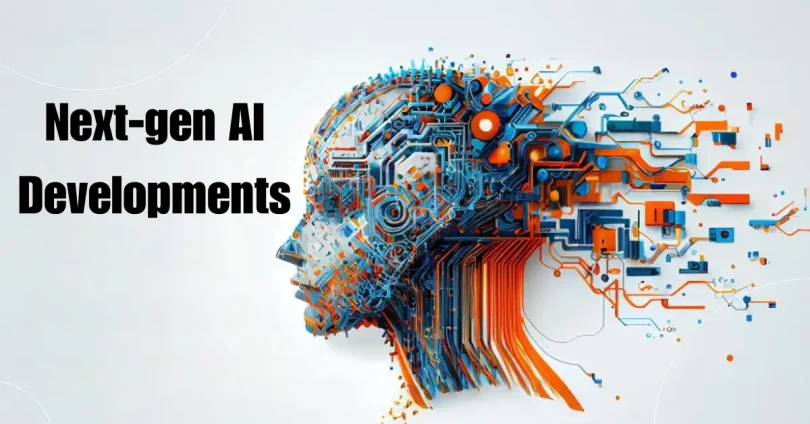Artificial Intelligence (AI) has experienced rapid advancements over the past few decades, bringing profound changes to industries, economies, and daily life. As we continue to move forward, the next generation of AI is expected to push the boundaries of what machines can achieve, moving beyond task-specific functions toward more sophisticated, flexible, and autonomous systems.
These next-gen AI developments are expected to not only revolutionize industries but also create new opportunities and challenges. This article offers a detailed exploration of these developments, focusing on key advancements that are shaping the future of AI.
1. Next-gen AI and Quantum Computing: Revolutionizing Machine Learning
 One of the most promising next-gen AI developments lies in the intersection of AI and quantum computing. Quantum computing represents a fundamental shift from classical computing, exploiting the principles of quantum mechanics to perform calculations in ways that classical computers cannot. When combined with AI, quantum computing could radically accelerate machine learning processes, enabling faster and more efficient data analysis.
One of the most promising next-gen AI developments lies in the intersection of AI and quantum computing. Quantum computing represents a fundamental shift from classical computing, exploiting the principles of quantum mechanics to perform calculations in ways that classical computers cannot. When combined with AI, quantum computing could radically accelerate machine learning processes, enabling faster and more efficient data analysis.
Quantum Machine Learning (QML)
Quantum machine learning is an emerging field that aims to harness the unique capabilities of quantum computers to enhance machine learning algorithms. Traditional machine learning methods struggle with processing vast amounts of data, but quantum computers can potentially solve these problems in much less time, offering a significant speed-up in training machine learning models. For instance, problems that might take traditional computers years to solve could potentially be completed in seconds on a quantum computer.
Quantum computers leverage quantum bits or qubits, which can exist in multiple states simultaneously (a phenomenon known as superposition). This allows quantum computers to explore numerous possibilities in parallel, making them ideal for complex calculations. In the context of machine learning, this means AI models could be trained more efficiently, with the ability to handle larger datasets and more intricate relationships.
Applications in Optimization
Next-gen AI combined with quantum computing has the potential to revolutionize optimization problems. For example, businesses that rely on logistics, supply chains, and route planning could see vast improvements in performance. Quantum computers could identify the most efficient routes for delivery trucks, manage inventory better, and forecast demand more accurately, resulting in cost savings and improved customer satisfaction.
By accelerating AI model training and improving optimization, quantum computing could lead to groundbreaking advancements in various fields, including finance, energy, and healthcare.
You may also like to read this:
The Latest Innovations In Technology Shaping Healthcare
Future Tech Trends 2024: Key Advancements Expected
How Quantum Computing Will Change The World?: A Guide
Top Best Future Tech Gadgets To Watch In 2024 You Need
What Is The Future Of AI And Machine Learning? In 2025?
The Role Of Nanotechnology In Future Tech: Healthcare Impact
How AI Is Shaping The Future Workforce? In 2025
2. Artificial General Intelligence (AGI): Moving Toward Human-Like Cognition
Artificial General Intelligence (AGI) represents the ultimate goal for AI researchers: an AI system that can perform any intellectual task that a human being can do. Unlike narrow AI systems, which excel in specific tasks (e.g., playing chess, translating languages), AGI would be capable of adapting to new situations, transferring knowledge across domains, and learning without human intervention.
Self-Learning AI
A core feature of AGI is self-learning, where an AI system can autonomously acquire knowledge from its environment without explicit programming. Self-learning systems would be able to understand new concepts and adapt to new tasks, much like humans do. Such systems would require advanced algorithms capable of generalizing knowledge, inferring patterns from limited data, and continuously improving over time.
One of the key challenges in creating self-learning AI is the need for systems that can not only learn from direct experience but also apply that knowledge to different contexts. For example, a self-learning AI trained to identify patterns in financial data should be able to apply similar logic to medical data, creating an entirely new domain of knowledge.
Cross-Domain Learning
Next-gen AGI systems would have the ability to transfer knowledge between different domains. This is known as cross-domain learning, and it enables AI systems to apply insights gained in one area to other, unrelated areas. For example, an AGI trained in the field of robotics might apply insights into mechanical systems to solve challenges in fields like construction, healthcare, or logistics. This cross-domain adaptability is a hallmark of human intelligence and is a critical component of the AGI vision.
Ethical and Governance Challenges
With AGI comes a host of ethical and governance challenges. If AI systems become as capable as humans in general intelligence, they could potentially make decisions that impact society in profound ways. Ensuring that AGI is developed responsibly and aligned with human values will be crucial in preventing unintended consequences. These include issues around job displacement, decision-making transparency, and ensuring that AGI is used for the benefit of society rather than for malicious purposes.
3. Next-gen AI in Autonomous Systems and Robotics
AI is already playing a significant role in autonomous systems, with self-driving cars, drones, and robots becoming more prevalent. The next generation of AI will further enhance these autonomous systems, enabling them to perform more complex tasks, adapt to unpredictable environments, and collaborate seamlessly with humans.
AI-Powered Robotics
Next-gen AI-powered robots are designed to perform tasks that require dexterity, precision, and flexibility. In fields such as manufacturing, healthcare, and agriculture, robots can be equipped with advanced AI algorithms to improve their efficiency and adaptability. For instance, robots in warehouses can autonomously pick and pack items based on real-time inventory data, while medical robots could assist in surgeries with extreme precision.
These robots will be equipped with advanced sensors, machine vision, and AI-driven decision-making algorithms, allowing them to understand and interact with their environment in real time. Autonomous robots can perform intricate operations like welding, assembling parts, and even cleaning in hazardous environments, thus reducing human risk and increasing productivity.
Swarm Robotics
One of the most exciting next-gen AI developments in robotics is the concept of swarm robotics. This technology involves multiple robots working in unison, communicating and coordinating their actions autonomously. Swarm robotics can be particularly useful in tasks like search and rescue operations, agricultural management, and environmental monitoring.
For example, in an agricultural setting, a fleet of small robots could work together to plant seeds, water crops, or detect pests, significantly improving efficiency and reducing human labor. These robots would use AI to adapt to changing conditions and collaborate in a way that maximizes output while minimizing environmental impact.
Human-Robot Collaboration
Rather than replacing humans, next-gen AI-powered robots will work alongside humans in collaborative environments. In the healthcare sector, AI-driven robotic systems could assist surgeons with precise operations or help elderly individuals with daily tasks. In manufacturing, robots will assist workers by performing dangerous tasks like lifting heavy loads or handling hazardous materials, while humans focus on higher-level decision-making and troubleshooting.
4. Next-gen AI in Natural Language Processing (NLP)
 Next-gen developments in Natural Language Processing (NLP) aim to make interactions between humans and machines more fluid and natural. As AI systems improve their ability to understand and generate human language, they will become more effective in communication and problem-solving.
Next-gen developments in Natural Language Processing (NLP) aim to make interactions between humans and machines more fluid and natural. As AI systems improve their ability to understand and generate human language, they will become more effective in communication and problem-solving.
Conversational AI
Next-gen NLP will see the rise of conversational AI systems that can hold coherent, context-aware, and emotionally intelligent conversations. These AI systems will not only understand basic language but also comprehend nuances, tone, and even emotional cues. This will improve interactions between humans and virtual assistants (such as Siri, Alexa, or Google Assistant) and enable them to answer more complex questions, understand context over multiple exchanges, and make personalized suggestions.
Multilingual Capabilities
Next-gen NLP will break down language barriers with more accurate and contextually relevant real-time translation. AI will be able to not only translate words but also interpret cultural nuances, idioms, and expressions, making cross-cultural communication more seamless. Businesses and governments will leverage this ability to engage with global audiences and streamline international collaboration.
AI in Creative Fields
In the creative industries, next-gen AI will play a crucial role in generating music, art, and literature. AI systems are already generating impressive works of music and art, and the future promises even more advanced systems that collaborate with human creators. For instance, an AI could compose music based on a user’s mood, write poetry, or even draft the plot of a novel.
5. Next-gen AI in Healthcare: Precision Medicine and Advanced Diagnostics
AI is already transforming the healthcare sector, but next-gen AI will take these advancements even further, particularly in the realms of precision medicine, diagnostics, and drug discovery.
Personalized Healthcare
With AI’s ability to analyze large volumes of genetic, medical, and lifestyle data, next-gen AI will enable doctors to provide more personalized care. AI systems could predict an individual’s susceptibility to certain conditions based on genetic markers and lifestyle choices, allowing for early intervention and prevention. Personalized treatment plans could be developed, ensuring the most effective therapies are used for each patient based on their specific genetic and health profile.
AI in Diagnostics
AI-powered diagnostic tools will become more advanced, improving the accuracy and speed of diagnosing diseases such as cancer, neurological disorders, and cardiovascular diseases. Machine learning algorithms can be trained on vast datasets of medical images, genetic data, and patient histories to identify subtle patterns that may be missed by human doctors. This could lead to earlier detection of diseases, improving patient outcomes and reducing healthcare costs.
AI in Drug Discovery
AI is already accelerating the process of drug discovery by analyzing large datasets to identify promising compounds. Next-gen AI will push this further by simulating how these compounds interact with biological systems, speeding up the development of new treatments for diseases like cancer, Alzheimer’s, and rare genetic disorders.
6. Ethical AI: Ensuring Fairness and Transparency
As AI becomes more integrated into our daily lives, ethical considerations regarding bias, fairness, and transparency become increasingly important. Next-gen AI systems will need to address these issues to ensure they benefit society and avoid unintended harm.
Bias Mitigation
AI models can inadvertently perpetuate biases present in training data, leading to unfair or discriminatory outcomes. Next-gen AI will include sophisticated methods for detecting and mitigating biases, ensuring that AI systems make fair and equitable decisions across sectors like hiring, lending, and law enforcement.
Explainable AI (XAI)
One of the key challenges with current AI systems is the lack of transparency in their decision-making processes. Next-gen AI will prioritize explainability, providing clear explanations for the reasoning behind AI decisions. This is particularly important in fields like healthcare, finance, and the criminal justice system, where AI decisions have significant consequences.
AI Governance and Regulation
As AI continues to evolve, regulatory frameworks will need to be developed to ensure that AI is used responsibly and ethically. These regulations will focus on ensuring privacy, security, and fairness, as well as providing guidelines for AI system transparency and accountability.
Conclusion
Next-gen AI developments are poised to revolutionize how we interact with technology, how industries operate, and how society functions. From the convergence of AI and quantum computing to the rise of AGI and advancements in robotics, healthcare, and natural language processing, the possibilities are vast and exciting. However, these developments also present new challenges, particularly in areas of ethics, governance, and bias mitigation.
As we continue to develop and deploy these next-gen AI systems, it is crucial to strike a balance between innovation and responsible usage, ensuring that AI benefits society as a whole. With careful oversight and collaboration, next-gen AI can become a powerful tool for solving some of the world’s most pressing challenges while improving the quality of life for individuals and communities worldwide.
FAQs
1. What are next-gen AI developments?
Next-gen AI developments focus on enhancing AI systems to be more intelligent, adaptive, and capable of performing complex tasks. Key advancements include integrating quantum computing, pursuing Artificial General Intelligence (AGI), improving robotics, Natural Language Processing (NLP), AI in healthcare, and addressing ethical concerns.
2. What is Artificial General Intelligence (AGI)?
AGI is a form of AI that can perform any intellectual task that humans can do. Unlike narrow AI, which excels in specific tasks, AGI is designed to learn, adapt, and solve problems across multiple domains.
3. How does quantum computing enhance AI?
Quantum computing accelerates AI by enabling faster data processing through quantum bits (qubits), making AI tasks like optimization, machine learning, and complex problem-solving more efficient and scalable.
4. What is Quantum Machine Learning (QML)?
QML combines quantum computing and machine learning to enhance AI performance by processing large datasets faster and solving problems that are difficult for classical computers.
5. How will AI impact robotics?
Next-gen AI will make robots smarter, more autonomous, and capable of performing complex tasks. This will transform industries like manufacturing, healthcare, and agriculture by improving efficiency, precision, and collaboration with humans.







